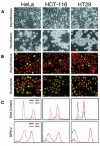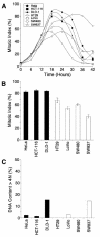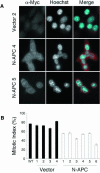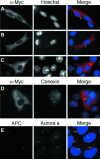Aneuploid colon cancer cells have a robust spindle checkpoint
- PMID: 11454737
- PMCID: PMC1083941
- DOI: 10.1093/embo-reports/kve127
Aneuploid colon cancer cells have a robust spindle checkpoint
Abstract
Colon cancer cells frequently display minisatellite instability (MIN) or chromosome instability (CIN). While MIN is caused by mismatch repair defects, the lesions responsible for CIN are unknown. The observation that CIN cells fail to undergo mitotic arrest following spindle damage suggested that mutations in spindle checkpoint genes may account for CIN. However, here we show that CIN cells do undergo mitotic arrest in response to spindle damage. Although the maximum mitotic index achieved by CIN lines is diminished relative to MIN lines, CIN cells clearly have a robust spindle checkpoint. Consistently, mutations in spindle checkpoint genes are rare in human tumours. In contrast, the adenomatous polyposis coli (APC) gene is frequently mutated in CIN cells. Significantly, we show here that expression of an APC mutant in MIN cells reduces the mitotic index following spindle damage to a level observed in CIN cells, suggesting that APC dysfunction may contribute to CIN.
Figures




References
-
- Cahill D.P., Lengauer, C., Yu, J., Riggins, G.J., Willson, J.K., Markowitz, S.D., Kinzler, K.W. and Vogelstein, B. (1998) Mutations of mitotic checkpoint genes in human cancers. Nature, 392, 300–303. - PubMed
-
- Cahill D.P., da Costa, L.T., Carson-Walter, E.B., Kinzler, K.W., Vogelstein, B. and Lengauer, C. (1999a) Characterization of MAD2B and other mitotic spindle checkpoint genes. Genomics, 58, 181–187. - PubMed
-
- Cahill D.P., Kinzler, K.W., Vogelstein, B. and Lengauer, C. (1999b) Genetic instability and Darwinian selection in tumours. Trends Cell Biol., 9, M57–M60. - PubMed
Publication types
MeSH terms
Substances
LinkOut - more resources
Full Text Sources

